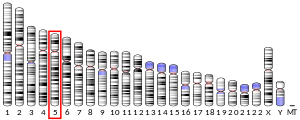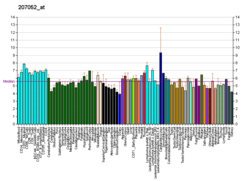HAVCR1
Hepatitis A virus cellular receptor 1 (HAVcr-1) also known as T-cell immunoglobulin and mucin domain 1 (TIM-1) is a protein that in humans is encoded by the HAVCR1 gene.[3][4][5]
| HAVCR1 | |||||||||||||||||||||||||
|---|---|---|---|---|---|---|---|---|---|---|---|---|---|---|---|---|---|---|---|---|---|---|---|---|---|
| |||||||||||||||||||||||||
| Identifiers | |||||||||||||||||||||||||
| Aliases | HAVCR1, HAVCR, HAVCR-1, KIM-1, KIM1, TIM, TIM-1, TIM1, TIMD-1, TIMD1, CD365, hepatitis A virus cellular receptor 1 | ||||||||||||||||||||||||
| External IDs | OMIM: 606518 HomoloGene: 134424 GeneCards: HAVCR1 | ||||||||||||||||||||||||
| |||||||||||||||||||||||||
| |||||||||||||||||||||||||
| |||||||||||||||||||||||||
| Orthologs | |||||||||||||||||||||||||
| Species | Human | Mouse | |||||||||||||||||||||||
| Entrez |
| ||||||||||||||||||||||||
| Ensembl |
| ||||||||||||||||||||||||
| UniProt |
| ||||||||||||||||||||||||
| RefSeq (mRNA) |
| ||||||||||||||||||||||||
| RefSeq (protein) |
| ||||||||||||||||||||||||
| Location (UCSC) | Chr 5: 157.03 – 157.06 Mb | n/a | |||||||||||||||||||||||
| PubMed search | [2] | n/a | |||||||||||||||||||||||
| Wikidata | |||||||||||||||||||||||||
| |||||||||||||||||||||||||
It is also known as KIM-1 Kidney Injury Molecule -1, which is a protein the most highly upregulated in injured kidneys by various types of insults. Its upregulation during renal injury has been found in the kidneys of the vertebrates such as Zebrafish and humans.
The hepatitis A virus cellular receptor 1 (HAVCR1/TIM-1), is a member of the TIM (T cell transmembrane, immunoglobulin, and mucin) gene family, which plays critical roles in regulating immune cell activity especially regarding the host response to viral infection. TIM-1 is also involved in allergic response, asthma, and transplant tolerance.
The TIM gene family was first cloned from the mouse model of asthma in 2001.[4] Subsequently, it was demonstrated that members of the TIM gene family including TIM-1 participate in host immune response. The mouse TIM gene family contains eight members (TIM-1-8) while only three TIM genes (TIM-1, TIM-3, and TIM-4) have been identified in humans.
Structure and function
TIM genes belong to type I cell-surface glycoproteins, which include an N-terminal immunoglobulin (Ig)-like domain, a mucin domain with distinct length, a single transmembrane domain, and a C-terminal short cytoplasmic tail. The localization and functions of TIM genes are divergent between each member. TIM-1 is preferentially expressed on Th2 cells and has been identified as a stimulatory molecule for T-cell activation.[6] TIM-3 is preferentially expressed on Th1 and Tc1 cells and function as an inhibitory molecule, which mediated apoptosis of Th1 and Tc1 cells.[7] TIM-4 is preferentially expressed on antigen-presenting cells, modulating the phagocytosis of apoptotic cells by interacting with phosphatidylserine (PS) exposed on apoptotic cell surface.[8]
Role in viral infection
TIM genes are also involved in host-virus interaction. As receptors for phosphatidylserine, TIM proteins bind many families of viruses [filovirus, flavivirus, New World arenavirus and alphavirus] that include viruses such as dengue and ebola. Entry of Lassa fever virus, influenza A virus, and SARS coronavirus were not affected by TIM-1 expression. TIM-1 and TIM-4 enhanced viral entry more than TIM-3.[9]
Hepatitis A
TIM-1 has been identified as the cellular receptor of hepatitis A virus (HAV). The mucin domain and IgV domain were critical for virus uncoating and infectivity. By using an expression cloning library, IgA has been demonstrated as a specific ligand of TIM-1. The association of TIM-1 and IgA was able to enhance the virus-receptor interaction.[10]
Ebola
Recently, TIM-1 has been shown to be a receptor or cofactor for Ebola virus entry. TIM-1 binds to Ebola virus glycoproteins (GP) and mediates Ebola virus cellular entry by increasing Ebola virus infectivity in cell lines with a low susceptibility. Moreover, reducing expression of endogenous TIM-1 in highly permissive cell lines decreased Ebola virus infectivity.[11] Furthermore, TIM-1 IgV domain specific antibody ARD5 inhibited Ebola virus infectivity, indicating that TIM-1 was critical for Ebola virus entry. Also, TIM-1 expression on human mucosal epithelial cells from the trachea, cornea and conjunctiva demonstrated the correlation of TIM-1 expression feature and viral entry routes.
Dengue
TIM-1 has been identified as a cellular factor for Dengue virus entry by overexpression of TIM-1 on poorly susceptible cell lines for Dengue virus infection. TIM-1 enhanced dengue virus infectivity by 500-fold, particularly increased virus internalization. TIM-1 directly interacted with Dengue virus particle by recognizing PS on the virion surface.[12] In addition, the Dengue virus susceptibility of different cell lines was consistent with endogenous expression level of TIM-1 gene in such cell lines, suggesting that TIM-1 is crucial for Dengue virus entry.
References
- GRCh38: Ensembl release 89: ENSG00000113249 - Ensembl, May 2017
- "Human PubMed Reference:". National Center for Biotechnology Information, U.S. National Library of Medicine.
- Feigelstock D, Thompson P, Mattoo P, Zhang Y, Kaplan GG (Aug 1998). "The human homolog of HAVcr-1 codes for a hepatitis A virus cellular receptor". Journal of Virology. 72 (8): 6621–6628. doi:10.1128/JVI.72.8.6621-6628.1998. PMC 109848. PMID 9658108.
- McIntire JJ, Umetsu SE, Akbari O, Potter M, Kuchroo VK, Barsh GS, Freeman GJ, Umetsu DT, DeKruyff RH (November 2001). "Identification of Tapr (an airway hyperreactivity regulatory locus) and the linked Tim gene family". Nature Immunology. 2 (12): 1109–1116. doi:10.1038/ni739. PMID 11725301.
- "Entrez Gene: HAVCR1 hepatitis A virus cellular receptor 1".
- Umetsu SE, Lee WL, McIntire JJ, Downey L, Sanjanwala B, Akbari O, Berry GJ, Nagumo H, Freeman GJ, Umetsu DT, DeKruyff RH (May 2005). "TIM-1 induces T cell activation and inhibits the development of peripheral tolerance". Nature Immunology. 6 (5): 447–454. doi:10.1038/ni1186. PMID 15793575.
- Zhu C, Anderson AC, Schubart A, Xiong H, Imitola J, Khoury SJ, Zheng XX, Strom TB, Kuchroo VK (December 2005). "The Tim-3 ligand galectin-9 negatively regulates T helper type 1 immunity". Nature Immunology. 6 (12): 1245–1252. doi:10.1038/ni1271. PMID 16286920.
- Kobayashi N, Karisola P, Peña-Cruz V, Dorfman DM, Jinushi M, Umetsu SE, Butte MJ, Nagumo H, Chernova I, Zhu B, Sharpe AH, Ito S, Dranoff G, Kaplan GG, Casasnovas JM, Umetsu DT, Dekruyff RH, Freeman GJ (December 2007). "TIM-1 and TIM-4 glycoproteins bind phosphatidylserine and mediate uptake of apoptotic cells". Immunity. 27 (6): 927–940. doi:10.1016/j.immuni.2007.11.011. PMC 2757006. PMID 18082433.
- Jemielity S, Wang JJ, Chan YK, Ahmed AA, Li W, Monahan S, Bu X, Farzan M, Freeman GJ, Umetsu DT, Dekruyff RH, Choe H (March 2013). "TIM-family proteins promote infection of multiple enveloped viruses through virion-associated phosphatidylserine". PLOS Pathogens. 9 (3): e1003232. doi:10.1371/journal.ppat.1003232. PMC 3610696. PMID 23555248.
- Tami C, Silberstein E, Manangeeswaran M, Freeman GJ, Umetsu SE, DeKruyff RH, Umetsu DT, Kaplan GG (April 2007). "Immunoglobulin A (IgA) is a natural ligand of hepatitis A virus cellular receptor 1 (HAVCR1), and the association of IgA with HAVCR1 enhances virus-receptor interactions". Journal of Virology. 81 (7): 3437–3446. doi:10.1128/JVI.01585-06. PMC 1866050. PMID 17229699.
- Kondratowicz AS, Lennemann NJ, Sinn PL, Davey RA, Hunt CL, Moller-Tank S, Meyerholz DK, Rennert P, Mullins RF, Brindley M, Sandersfeld LM, Quinn K, Weller M, McCray PB, Chiorini J, Maury W (May 2011). "T-cell immunoglobulin and mucin domain 1 (TIM-1) is a receptor for Zaire Ebolavirus and Lake Victoria Marburgvirus". Proceedings of the National Academy of Sciences, USA. 108 (20): 8426–8431. Bibcode:2011PNAS..108.8426K. doi:10.1073/pnas.1019030108. PMC 3100998. PMID 21536871.
- Meertens L, Carnec X, Lecoin MP, Ramdasi R, Guivel-Benhassine F, Lew E, Lemke G, Schwartz O, Amara A (October 2012). "The TIM and TAM families of phosphatidylserine receptors mediate dengue virus entry". Cell Host Microbe. 12 (4): 544–557. doi:10.1016/j.chom.2012.08.009. PMC 3572209. PMID 23084921.
Further reading
- Kumanogoh A, Kikutani H (2004). "Immune semaphorins: a new area of semaphorin research". Journal of Cell Science. 116 (Pt 17): 3463–3470. doi:10.1242/jcs.00674. PMID 12893810.
- McIntire JJ, Umetsu DT, DeKruyff RH (2004). "TIM-1, a novel allergy and asthma susceptibility gene". Springer Seminars in Immunopathology. 25 (3–4): 335–348. doi:10.1007/s00281-003-0141-3. PMID 15007635.
- Thompson P, Lu J, Kaplan GG (1998). "The Cys-rich region of hepatitis A virus cellular receptor 1 is required for binding of hepatitis A virus and protective monoclonal antibody 190/4". Journal of Virology. 72 (5): 3751–3761. doi:10.1128/JVI.72.5.3751-3761.1998. PMC 109597. PMID 9557657.
- Bailly V, Zhang Z, Meier W, Cate R, Sanicola M, Bonventre JV (2002). "Shedding of kidney injury molecule-1, a putative adhesion protein involved in renal regeneration". Journal of Biological Chemistry. 277 (42): 39739–39748. doi:10.1074/jbc.M200562200. PMID 12138159.
- Noguchi E, Nakayama J, Kamioka M, Ichikawa K, Shibasaki M, Arinami T (2003). "Insertion/deletion coding polymorphisms in hHAVcr-1 are not associated with atopic asthma in the Japanese population". Genes and Immunity. 4 (2): 170–173. doi:10.1038/sj.gene.6363935. PMID 12618867.
- McIntire JJ, Umetsu SE, Macaubas C, Hoyte EG, Cinnioglu C, Cavalli-Sforza LL, Barsh GS, Hallmayer JF, Underhill PA, Risch NJ, Freeman GJ, DeKruyff RH, Umetsu DT (2003). "Immunology: hepatitis A virus link to atopic disease". Nature. 425 (6958): 576. Bibcode:2003Natur.425..576M. doi:10.1038/425576a. PMID 14534576.
- Chae SC, Song JH, Heo JC, Lee YC, Kim JW, Chung HT (2004). "Molecular variations in the promoter and coding regions of human Tim-1 gene and their association in Koreans with asthma". Human Immunology. 64 (12): 1177–1182. doi:10.1016/j.humimm.2003.09.011. PMID 14630400.
- Chae SC, Song JH, Lee YC, Kim JW, Chung HT (2004). "The association of the exon 4 variations of Tim-1 gene with allergic diseases in a Korean population". Biochemical and Biophysical Research Communications. 312 (2): 346–350. doi:10.1016/j.bbrc.2003.10.125. PMID 14637143.
- Vilà MR, Kaplan GG, Feigelstock D, Nadal M, Morote J, Porta R, Bellmunt J, Meseguer A (2004). "Hepatitis A virus receptor blocks cell differentiation and is overexpressed in clear cell renal cell carcinoma". Kidney International. 65 (5): 1761–1773. doi:10.1111/j.1523-1755.2004.00601.x. PMID 15086915.
- Mesri M, Smithson G, Ghatpande A, Chapoval A, Shenoy S, Boldog F, Hackett C, Pena CE, Burgess C, Bendele A, Shimkets RA, Starling GC (2006). "Inhibition of in vitro and in vivo T cell responses by recombinant human Tim-1 extracellular domain proteins". International Immunology. 18 (3): 473–484. doi:10.1093/intimm/dxh388. PMID 16481347.
- Lim J, Hao T, Shaw C, Patel AJ, Szabó G, Rual JF, Fisk CJ, Li N, Smolyar A, Hill DE, Barabási AL, Vidal M, Zoghbi HY (2006). "A protein-protein interaction network for human inherited ataxias and disorders of Purkinje cell degeneration". Cell. 125 (4): 801–814. doi:10.1016/j.cell.2006.03.032. PMID 16713569.
- Kotsis F, Nitschke R, Boehlke C, Bashkurov M, Walz G, Kuehn EW (2007). "Ciliary calcium signaling is modulated by kidney injury molecule-1 (Kim1)". Pflügers Archiv. 453 (6): 819–829. doi:10.1007/s00424-006-0168-0. PMID 17205356.


